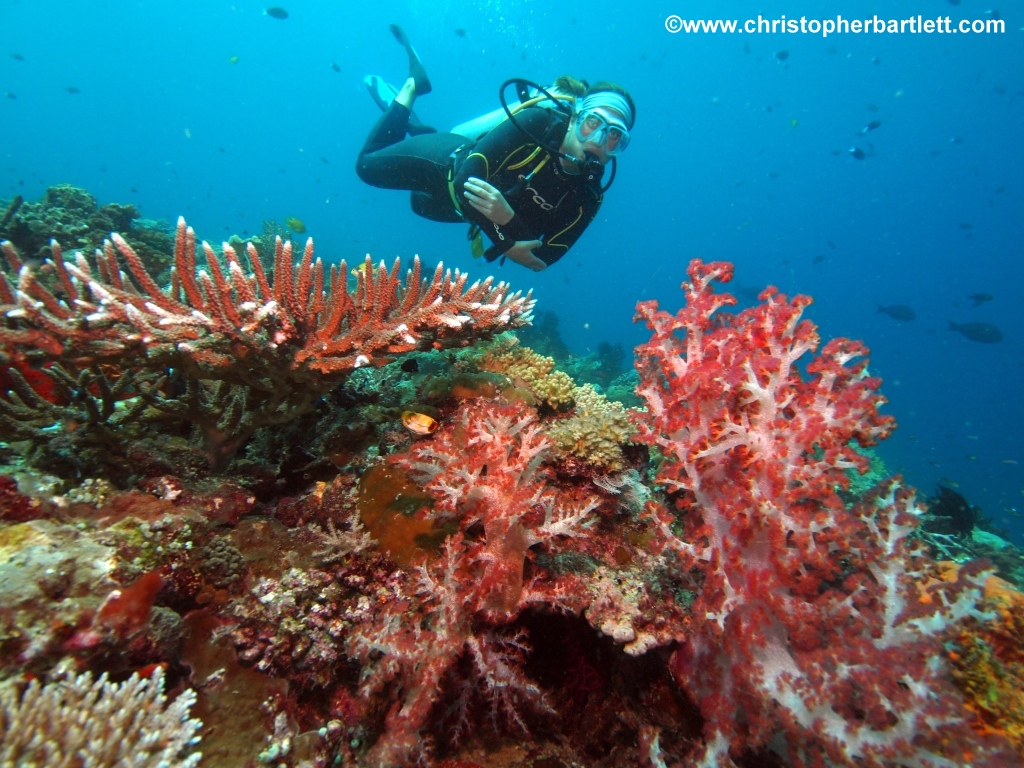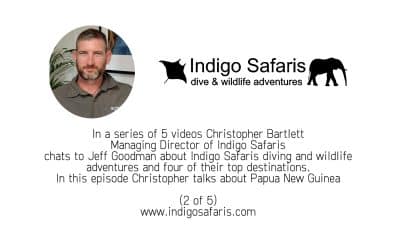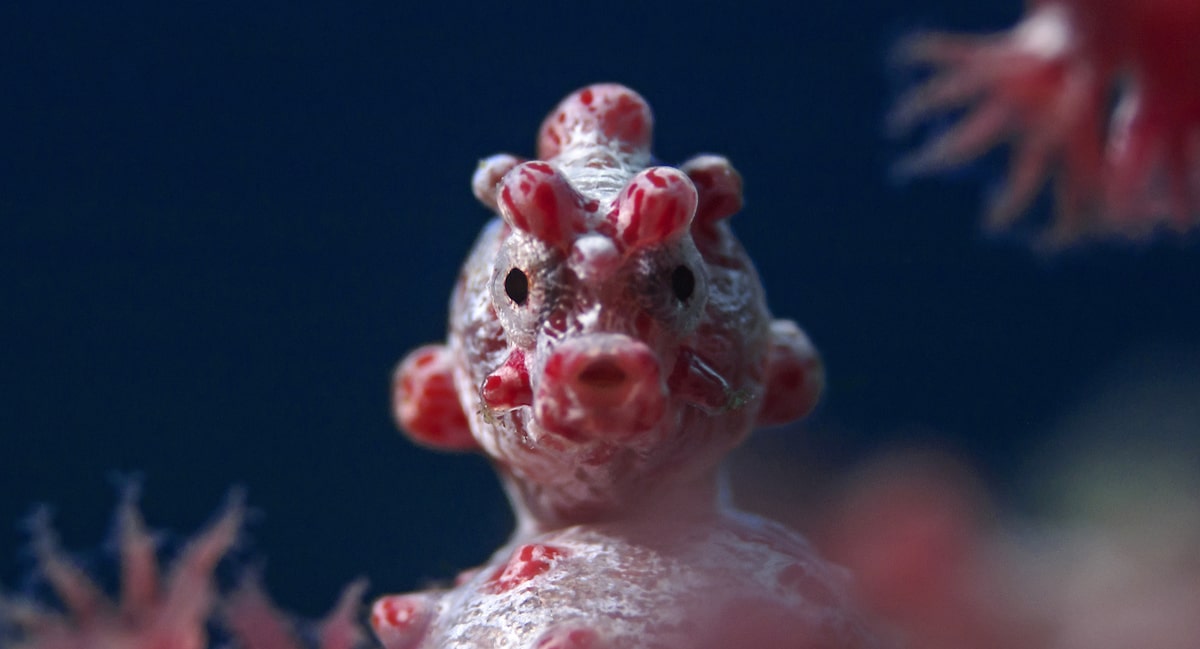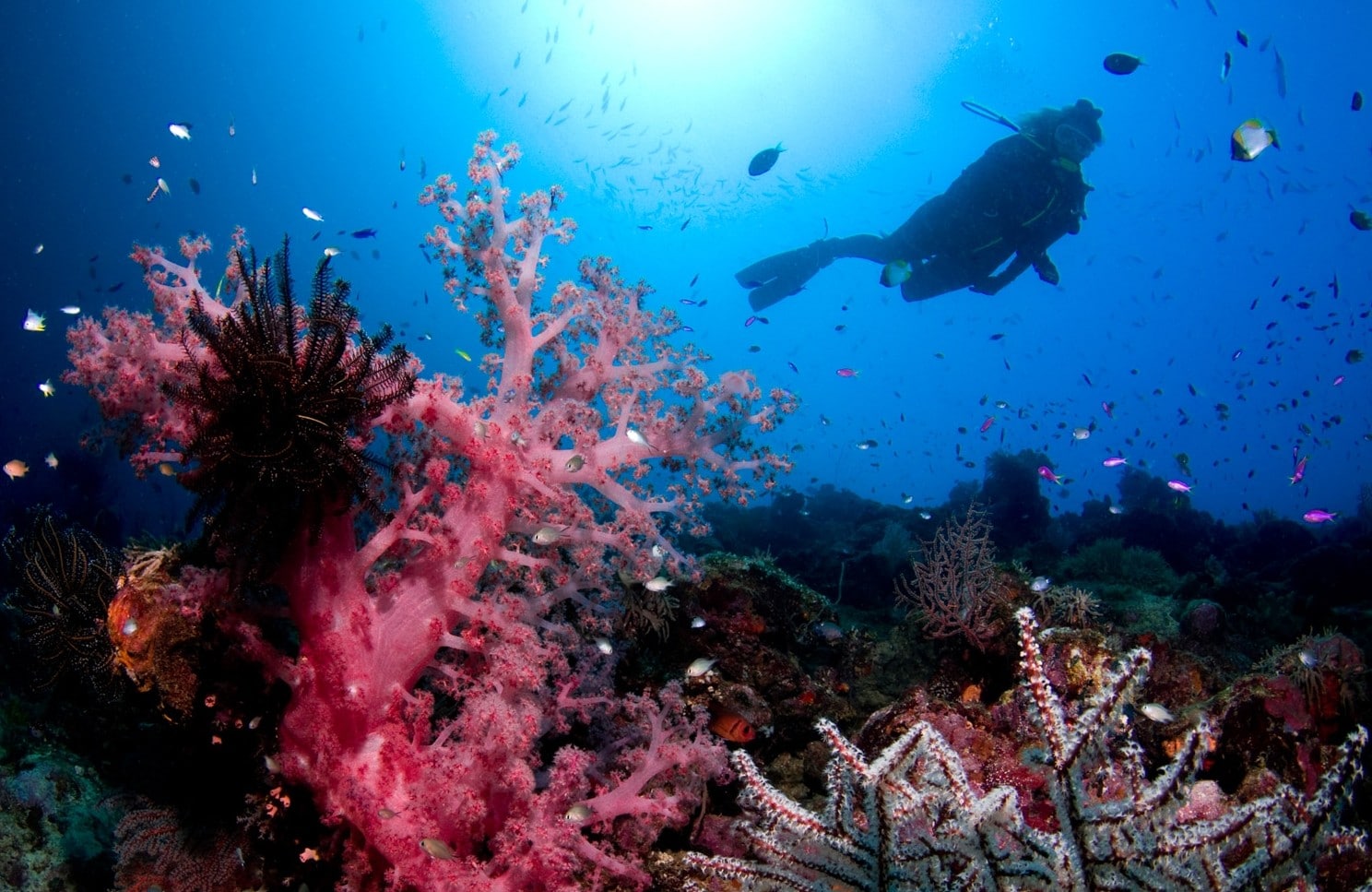Travel Stories
Lissenung Island – Paradise Found

Christopher travels to Lissenung Island in Papua New Guinea for a dream dive experience
Have you ever dreamt about staying on a remote tropical island, being lulled to sleep by the gentle lap of the waves on the white sand beach, the wind softly rustling the leaves of the palm trees, as images of the day’s diving among spectacular coral and schools of fish float through your mind?
Dream no more. Lissenung Island, twenty minutes by boat south of Kavieng harbour is that paradise island. Owned by Austrian ex-engineer Dietmar Amon and his wife Ange, its seven rooms are ideally located for diving both the South Pacific Ocean sites to the north and the Bismarck Sea sites to the south, and around the numerous small islands that cover the area. The usual routine sees the dive boat leave after breakfast and return for lunch. Afternoon dives leave around 3 PM, and dusk dives to look for the impossibly colourful mandarinfish can be organised.
The aptly nudibranch-shaped island is nestled half-way between the jaws of western New Ireland, and has coral reef around two-thirds of its small shore. I say aptly named as although New Ireland has a deserved reputation for big schools of pelagics, from bumphead parrotfish to silvertip sharks, Dietmar is an ardent fan of the oceans’ smaller, slower occupants.
Nudibranchs, a sort of brightly coloured sea slug of which there are over 800 species, and cowries, marine molluscs, are amongst his favourite finds. Although they might sound like the underwater equivalent of spotting stationary trains, Dietmar has fascinating tales about their underwater feats. Who would have thought that one of the deadliest creatures in the ocean is the geographicus cone shell, also known as the cigarette snail, as smoking one last one is about all a human has time to do after being bitten by one.
We arrived for lunch, and as we strode ashore and up the short beach to be greeted by our hosts, it was impossible not to break into a grin. The only shoes we’d be wearing for a week were fins as the path from the restaurant to our chalet was velvety soft sand.
Straight after lunch we sorted our kit out, boarded the twin-hulled dive boat, and headed back to Kavieng harbour for an afternoon muck dive on an upturned Pete WW2 Japanese float plane, and around the wharf, where a decent number of the marine world’s weird and wonderful inhabitants such as ghost pipefish, nudibranchs and shrimps, octopus, and pipefish dwell.
The harbour tends to be a bit murky given its sandy bottom and protected nature, but the dives sites on the reefs between the islands were much clearer. The changing tides produce some strong currents that flush clear waters from the deep sea over the abundant reefs and through tiny passages. It is during those currents that the pelagics pitch up; Grey, blacktip, and whitetip reef sharks, tunas, mackerels, schools of jacks and barracudas are frequent visitors to the numerous dive sites to the north and the south.
The following morning we headed south to Danny’s Bommy. Starting at 7m, it is connected to the island via a saddle down at 15 metres, and on the outside it plummets straight down into the inky blue depths. We dropped in and headed down to 30 metres where a school of twenty-odd, large humphead parrotfish were cruising. They didn’t stop, and I think the coral must’ve been very pleased. These 40-kilo fish look like they could do some serious grazing with their beaks (really teeth fused together) and, unlike most other parrotfish, are partial to live coral as well as the algae that live on them. Coming back up I spied a white-bonnet anemonefish, the eighth of the nine species that live in PNG waters that I had seen. Now only the panda or saddleback anemone fish was missing. We ended the dive among the schools of fusiliers adorned the top of the coral-covered bommie, gazing into the blue.
[wppa type=”slideonlyf” album=”19″ align=”center”][/wppa]
After relaxing in the sun on the boat (there is plenty of shade, but I get plenty of that back home) with some fresh fruit, we headed over to Kavin II and its long wall for a spot of pygmy sea horse hunting on gorgonian fans. Nozaki, the resident instructor, soon gave me the underwater “look here, small stuff” sign, and sure enough, right where she was pointing, was a miniscule centimetre-long, knobbly pink seahorse. Amazing.
I snapped a few shots off before thinking that I had to be able to find it for myself before I could use the picture, otherwise it would be like getting someone to hunt trophies for you. I turned my head away and looked back. Gone. I knew what it looked like, I knew where it was to within a square metre, but, try as I might, I could not find it. I searched, my face inches from the fan, for several minutes, until I started to go cross-eyed and lose the ability to focus. Nozaki came back, waved her hand in front of the fan gently, and found it in under ten seconds, and left me to continue my challenge.
I tried the hand wave, more a flexing of the fingers than a regal Queen Liz special, and lo and behold something tiny was swaying before my squinting eyes, its tail curled around apiece of fan. I was a pygmy seahorse hunter and raised my camera and snapped away under the watchful eyes of a longnose hawkfish, whose presence I’d totally overlooked. So engrossed was I in my quest for one of PNG’s dive grails, I’d almost missed this photographer’s chalice. As I’d been down there for so long, it had got used to my presence and pouted for me until dive computer told me that it was time to ascend to shallower depths.
Closer to the surface my camera found little respite as Ange pointed out a leaf of seagrass that had legs and a pair of eyes. A superbly camouflaged halemeda crab was lurking on the wall. About 20 metres further along one of his cousins, the slightly more conspicuous but equally small orang-utan crab was trying to hide in a crack. After seventy minutes we were unsurprisingly low on air, low on battery, and pretty famished.
After lunch at the resort, a battery change, and a decent snooze, just before dusk we headed north to a destination known only as Nozaki’s Secret. It is listed on the dive site map, but not shown. Why the secrecy? Mandarinfish. These impossibly brightly coloured creatures attain six centimetres in length, and are nocturnal. Not surprising given how well they stand out in daylight. Odd as this may seem, it is part of their defensive system. One of the few scaleless fish species, they are protected by a toxic mucous and their Chinese lord’s robe motif is a good example of aposematic coloration – where toxic creatures warn potential predators of their inedibility through the use of bright colours.
Five metres below the surface, Nozaki set up two underwater torches on sticks to illuminate a head of finger coral and we settled in to watch the show. The males put on dancing displays to attract one of the numerous females. When a female was suitably impressed she would rub up against the male’s pelvic fin, the pair would rise up 50 centimetres from the coral head for 10 to 15 seconds, release a mixture of eggs and sperm, and then shoot back to the protection of the coral. Trying to get the camera to focus in the low light during one of these brief forays into the open proved to be quite a challenge, and we spent a good half an hour watching a succession of males dance and the subsequent mating.
Over the next four days we dived the best reefs to the north and the south, and enjoyed them all. Matrix has fantastic hard corals in the shallows and huge fan corals from 20m downwards make beautiful scenery. Drifting along, on the current the reef was a riot of vivid colours as anthias and butterfly fish danced around the corals. This is probably the most beautiful drift dive around Kavieng.
Peter’s Patch, at the south eastern tip of a large reef system in the Steffen Strait, is great for batfish and pelagics, with tuna and barracuda a-plenty. On the other end of the reef system lies Helmut’s Reef, and here we found leaf fish and white-bonnet anemonefish, one of the rarer of the nine species of anemonefish found in PNG.
But the best site in the area, in my opinion, is the amazing Albatross Passage. On an incoming tide this narrow passage between two islands is like fish soup. As water comes in from the deep and gets closer to a shelf nine metres below the surface it speeds up and draws in a myriad of fish life from the food chain. Schools of sardine-sized fusiliers and snappers looking for lunch brought by the upwelling waters attract dogtooth tunas and barracudas, which in turn attract grey reef, blacktip, whitetip and sometimes silvertip sharks. Eagle and devil rays are sometimes seen here, and hooking onto the top of the reef and watching the action over the top of the wall is a spectacular experience.
The wall itself is covered with big fan corals, black corals, soft branching coral, and sponges and this is the home for small creatures like nudibranchs, leaf fish, and scorpionfish. At around 30 metres there is a sandy shelf that does a good job of reflecting the light, and even when the current is pumping at the top, the deeper sections of the wall and the shelf are calm. On a foray to find more pygmy seahorses and long-nosed hawkfish, a large cuttlefish gave us a display of its ability to change colours. We dived this site three times, and would gladly go there every day.
Afternoon dives on the house reef that goes two-thirds of the way around the island are free, and much of the best stuff is in three metres of water, making it ideal for snorkelling too. It doesn’t take too much luck to get a glimpse of juvenile blacktip reef sharks around the far side of the island, but here I was interested in something a little more elusive. I had photographed eight of PNG’s nine anemonefish species, but was missing one. The panda or saddleback anemonefish. Wading into the water, past the seahorse lolling around like a seemingly listless drunk, I followed Dietmar’s directions to the mooring buoy, turned right, and swam over the sandy bottom for all of 30 seconds. Lo and behold, in a small anemone was my prize. And they weren’t alone. A couple of transparent anemone shrimp were out too, and kindly posed for me.
Several times a year, Lissenung’s twin-engined 26-foot Ozycat heads northwards to New Hanover on expeditions to explore virgin reefs, a Japanese two-man submarine, and Chapman’s reef and its resident giant groupers, staying in guesthouses on different islands depending on the itinerary. For Ange and Dietmar, this tiny island has become home, but for us, this was paradise.
Papua New Guinea travel: PNG is three hour’s flight time north of Australia, six hours from Singapore, and has weekly and twice weekly direct flights from a range of destinations like Manila, Cebu, Bali, Sydney, Cairns, Hong Kong and Tokyo. Within PNG, the best way (and often only) way to get around is by air either with Air Niugini or Airlines of PNG. Lissenung Island’s closest airport is Kavieng, and has daily flights from Port Moresby. Returns are around $400 USD.
Best of PNG put together tailor-made dive trips that can also take in the best Sing-Sings (cultural festivals) on the PNG calendar, trekking up Mt Wilhelm or the Kokoda Trail, and Sepik River expeditions. www.bestofpng.com
Blogs
Alonissos: The complete diving destination (Part 1)

In June we were incredibly fortunate to be invited to dive in Alonissos, a small Greek Island in the Sporades island chain located in the North Aegean Sea. While I have long been a big fan of the Greek Islands as a great holiday destination, I had not had the opportunity to do any diving on previous visits and Mike and I were extremely excited to see what Alonissos had to offer both above and below the surface!

The Sporades are easily accessible via the airport in Skiathos (the first island in the chain), which is served by Jet2 flights from all major UK airports from May through October. Numerous ferries and charter boats make island hopping from Skiathos Town a breeze. After an hour boat ride, the picturesque port of Patitiri was a wonderful introduction to Alonissos, where we were met by our gracious hosts Kostas of Albedo Travel and Dias of Alonissos Triton Dive Center. Mike and I were delighted to be staying at the Paradise Hotel, aptly named for its stunning views over the sea and great location for walking to the waterfront.

Alonissos is beautifully situated in the National Marine Park of Alonissos and the Northern Sporades, the largest marine protected area in Europe. The surrounding seas offer fabulous marine life, including incredibly rare species such as the Mediterranean monk seal. They boast deep walls covered in gorgonians and sponges, stunning topography with caverns, swimthroughs and pinnacles, and the first accessible ancient shipwreck from 500BC!

In locations where historical sites have been reported, the waters are largely restricted, but with collaboration between government, underwater archeologists and dive centres, incredible underwater museums are being created for a truly unique diving experience. Alonissos is home to the first of these, the Ancient Shipwreck of Peristera Accessible Underwater Archeological Site. The chance to dive into history (along with reports of healthy reef life and amazing underwater topography) meant Mike and I were keen to get in the water.

Our introduction to the diving around Alonissos was at the Agios Georgios Pinnacles, in the channel between Alonissos and Skopelos. This fantastic site was named “The Chimney,’ and proved to have a huge amount to see. We got to a decent depth here (over 25m), and marvelled at a colourful reef wall with a wonderful swim through whose rocky walls were absolutely covered with life. As well as brilliant topography there was no shortage of macro life here. We saw numerous nudibranchs, five different species in total. The second dive at Mourtias reef nearby was a shallower dive along a nice wall with lots of crevices. Several moray eels and grouper called this site home. We enjoyed looking in the crevices for lobster and smaller benthic life, such as cup corals and tunicates.

Our itinerary allowed us two dives a day with afternoons left to explore the island with our hire car and evenings to enjoy the famous Greek hospitality. This proved to be a lovely mix of in-water and land based diversions.

The next days diving to the Gorgonian Gardens and Triton’s Cave was to be even better! These two stunning sites are nothing short of fabulous. The Gorgonian Gardens was a deep wall near to the Agios Georgios islands. The ever-present currents in this deep channel meant that the sea life was amazing … the namesake Gorgonian sea fans dotted the wall at a depth of 30 to 50 meters, getting ever larger the deeper we went. Above 30m was by no means less beautiful, with sponges, corals, scorpionfish, moray eels and some rare and colourful nudibranchs.

The second shallower dive of the day was to Triton’s Cave or the Cavern of Skopelos, on the east side of that island. The spectacular rock formations had wild striations both above and below the water making a truly epic topography. The cavern entrance was at 14m, and big enough for a buddy pair, winding up to 6m and passing two beautiful windows out into the blue. Emerging from the cavern, the light at the shallower depths and the incredible rock formations made for a fantastic gentle swimming safety stop and we all surfaced by the boat with massive grins.

Check out our next blog :Alonissos: The complete diving destination (Part 2)” to hear about our amazing dive on the 2500 year old Peristera Wreck!
Thanks to:
Alonissos Triton Dive Center https://bestdivingingreece.com/
Albedo Travel https://alonissosholidays.com/activities/
Paradise Hotel https://paradise-hotel.gr/
Alonissos Municipality https://alonissos.gr/en/
Blogs
Mamma Mia! Diving Skopelos (Part 2)

Our second days dive itinerary was to the famous Christoforos wreck! This is arguably the best dive in Skopelos and though only open to divers with deep diving experience, this 83m long wreck is well worth the visit.
The Christoforos sits in 43 meters of water with the deck at 32 to 35 meters. A 30m dive can give an impressive view of the wreck, though such a large wreck needs a few dives to truly do it justice. Given its ideal location just a 2 minute boat ride from the dive centre dock it is an excellent first dive of the day. The sheltered site is also diveable in all but the absolute worst weather so although deep, the water is usually clear with little to no current making it a very pleasant dive. The site is superb for technical diving and a great training site for the Tec 40 and 45 programs, offered by Skopelos Dive Center.

The Christoforos wreck was originally a collier ship built in 1950 at Grangemouth shipyard under the name “Thomas Hardie”. In 1976 she joined the Greek merchant fleet as “Christoforos”. On the 2nd of October 1983 the Christoforos was carrying 2600 tonnes of cement from Volos to Piraeus Port. During the voyage the weather turned, resulting in the ship developing a 7 degree list, whereby she changed course for safe anchorage at Panormos, Skopelos. The ship reached Panormos at 16:00 with a list of 17 degrees and water ingress to No. 1 hull. Though attempts were made to right the vessel, the crew were ordered to abandon ship at 22:00. The captain, lieutenant and the quartermaster remained to try and save the ship, but had to abandon the attempt themselves and the Christoforos finally sank at 05:30 on 3rd October 1983. She now sits upright in 43 meters of water less than 200m from shore in Panormos.

Diving has only been allowed here since 2018, so the wreck is very well preserved and a real treat to dive. Permission to dive here was granted by the authorities after lots of incredibly hard work by the Skopelos Dive Center staff. Having a fantastic wreck in such an amazing location and in excellent condition is a real privilege.

Of all the sites in Skopelos this was the site Mike and I were most keen to experience. Having kitted up and zipped across the bay to the mooring, we left the surface and followed the descent line until the wreck emerged spectacularly from the blue at 15m. She is a big and beautiful wreck, sitting as though calmly continuing her journey along the seabed. With most of her original features still intact there were points of interest everywhere, including the anchors, winches, ships telegraphs, the wheel and RDF antenna.

We found that aquatic life had colonised the ship, with schools of fish, electric blue nudibranchs, a large moray eel and the resident scorpionfish lurking inside the bridge. The Christoforos was truly a stunning wreck and despite maximising our time at depth we eventually had to say our goodbyes and begin the slow and steady return to the surface.

After a superb morning dive we had the afternoon to do a little sightseeing of the island, with a trip to the church of Agios Ioannis Kastri made famous by the blockbuster movie “Mamma Mia!”. Mike and I spent a happy afternoon pootling around in our little hire car before meeting up with Lina from Skopelos Dive Center. An underwater archeologist as well as a dive professional, Lina had offered to show us a rather special attraction, the Christoforos shipwreck Digital Spot public information and awareness centre.

A fantastic initiative made possible from the collaboration of the government and hard work of the staff at Skopelos Dive Center is the “Digital Spot” in Agnontas port. This information center has a number of displays on the history of the Christoforos wreck, the process by which the wreck was allowed to be opened to the public for diving tourism, other sites of historical interest in the area, a video of the wreck and the best bit, a virtual reality dry dive experience! The beauty of the VR system is that non diving members of the family can see what you have seen on the wreck, or you can see areas that you may not have explored during the dive due to time or depth limitations. It was a truly immersive experience and a great addition to the dive itself.

After a wonderful day we celebrated our last evening on the island with an exquisite meal in Skopelos Town with fabulous views over the town and bay, washed down with the excellent local wine. The lamb with lemon and potatoes was a meal which I could happily eat every day for the rest of my life!

Skopelos is an island that truly has it all. The diving is excellent, the landscape is beautiful with plenty of non diving activities, the locals friendly and the food and drink superb. Given how accessible it is as a holiday destination it has avoided becoming overcrowded and even in peak season offers a fun yet relaxing atmosphere. We highly recommend giving Skopelos a visit. We will certainly be back again!
Thanks to:
Municipality of Skopelos (https://skopelos.com/)
Skopelos Dive Center (https://sporadesdiving.gr/)
Ionia Hotel (https://www.ioniahotel.gr/en)
Dolphin of Skopelos (https://dolphinofskopelos.com/)
Ta Kymata restaurant (@takymata)
The Muses restaurant (https://www.facebook.com/TheMussesMousses/)
Aktaiov resturant (https://skopelos.com/listings/aktaion-taverna/)
-

 Blogs2 months ago
Blogs2 months agoDiving With… Nico, Ocean Earth Travels, Indonesia
-

 News1 month ago
News1 month agoMurex Bangka Announce New Oceanfront Cottages & Beachfront Dining
-

 Blogs2 months ago
Blogs2 months agoA new idea in freediving from RAID
-

 Marine Life & Conservation1 month ago
Marine Life & Conservation1 month agoIceland issue millionaire whale hunter a licence to murder 128 vulnerable fin whales
-

 Marine Life & Conservation2 months ago
Marine Life & Conservation2 months agoThe Shark Trust Great Shark Snapshot is back
-

 News3 months ago
News3 months agoCharting New Waters; NovoScuba Goes Global with the Launch of their Revolutionary Dive Training Agency!
-

 Gear News1 month ago
Gear News1 month agoNew Suunto Ocean – a dive computer and GPS sports watch in one for adventures below and above the surface
-

 Marine Life & Conservation Blogs2 months ago
Marine Life & Conservation Blogs2 months agoBook Review: Plankton










